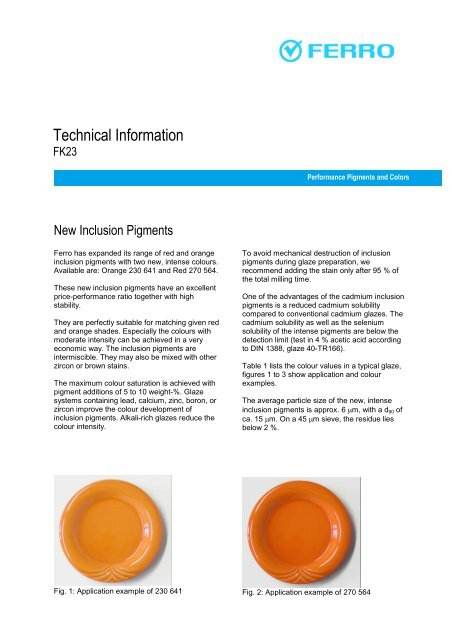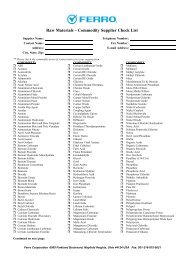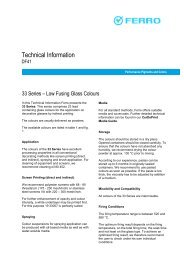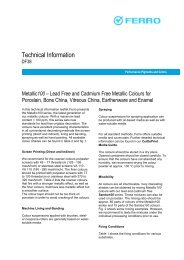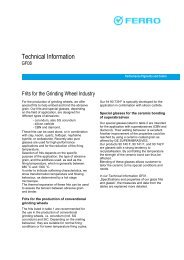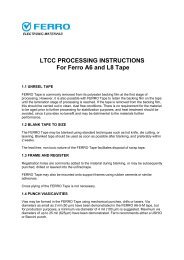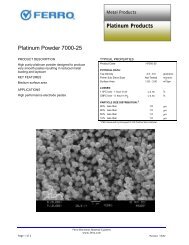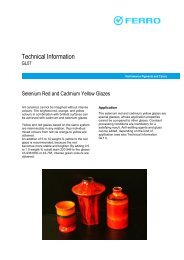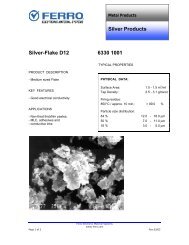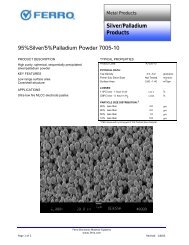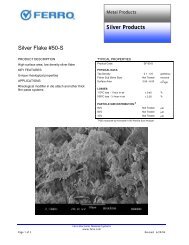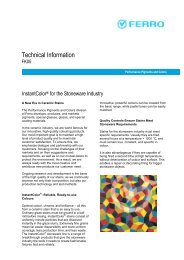New Inclusion Pigments Brochure - Ferro
New Inclusion Pigments Brochure - Ferro
New Inclusion Pigments Brochure - Ferro
Create successful ePaper yourself
Turn your PDF publications into a flip-book with our unique Google optimized e-Paper software.
Technical Information<br />
FK23<br />
<strong>New</strong> <strong>Inclusion</strong> <strong>Pigments</strong><br />
<strong>Ferro</strong> has expanded its range of red and orange<br />
inclusion pigments with two new, intense colours.<br />
Available are: Orange 230 641 and Red 270 564.<br />
These new inclusion pigments have an excellent<br />
price-performance ratio together with high<br />
stability.<br />
They are perfectly suitable for matching given red<br />
and orange shades. Especially the colours with<br />
moderate intensity can be achieved in a very<br />
economic way. The inclusion pigments are<br />
intermiscible. They may also be mixed with other<br />
zircon or brown stains.<br />
The maximum colour saturation is achieved with<br />
pigment additions of 5 to 10 weight-%. Glaze<br />
systems containing lead, calcium, zinc, boron, or<br />
zircon improve the colour development of<br />
inclusion pigments. Alkali-rich glazes reduce the<br />
colour intensity.<br />
Fig. 1: Application example of 230 641<br />
Performance <strong>Pigments</strong> and Colors<br />
To avoid mechanical destruction of inclusion<br />
pigments during glaze preparation, we<br />
recommend adding the stain only after 95 % of<br />
the total milling time.<br />
One of the advantages of the cadmium inclusion<br />
pigments is a reduced cadmium solubility<br />
compared to conventional cadmium glazes. The<br />
cadmium solubility as well as the selenium<br />
solubility of the intense pigments are below the<br />
detection limit (test in 4 % acetic acid according<br />
to DIN 1388, glaze 40-TR166).<br />
Table 1 lists the colour values in a typical glaze,<br />
figures 1 to 3 show application and colour<br />
examples.<br />
The average particle size of the new, intense<br />
inclusion pigments is approx. 6 m, with a d90 of<br />
ca. 15 m. On a 45 m sieve, the residue lies<br />
below 2 %.<br />
Fig. 2: Application example of 270 564
page 2/2 FK23 09/12<br />
230 641<br />
270 564<br />
Fig. 3: Colour examples of the inclusion pigments (5 %<br />
pigment addition in a transparent or opaque glaze,<br />
resp.)<br />
While every attempt has been made to reproduce<br />
colours exactly, the colour samples shown here may<br />
differ from fired ceramic products.<br />
PPCDSFK2309/12E<br />
<strong>Ferro</strong> GmbH Performance <strong>Pigments</strong> and Colours Gutleutstr. 215 60327 Frankfurt/M.<br />
Tel. ++49/(0)69/27116-432Fax ++49/(0)69/27116-243e-mail: pigments@ferro.com<br />
Table 1: Colourimetric values* of the intense<br />
inclusion pigments (5 weight-% pigment in<br />
transparent glaze, 1130 °C)<br />
Pigment Colour L* a* b* C* h*<br />
230 641 Orange 68,5 33,4 60,4 69,0 61,0<br />
270 564 Red 56,9 49,7 36,1 61,5 36,0<br />
*Measurement according to CIELAB 1976, 10° standard<br />
observer, D65<br />
The information and statements contained herein are provided free of charge. They are believed to be accurate at time of publication, but <strong>Ferro</strong><br />
makes no warranty with respect thereto, including but not limited to any results to be obtained or the infringement of any proprietary rights. Use<br />
or application of such information or statements is at user’s sole discretion, without any liability on <strong>Ferro</strong>´s part. Nothing herein shall be<br />
construed as a license of or recommendation for use that infringes upon any proprietary rights. All sales are subject to <strong>Ferro</strong>´s General<br />
Conditions of Sale and Delivery.


